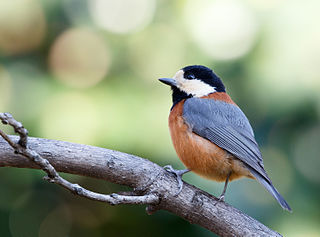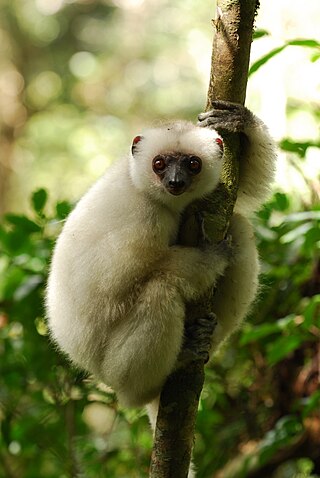
Sardine and pilchard are common names for various species of small, oily forage fish in the herring suborder Clupeoidei. The term 'sardine' was first used in English during the early 15th century; a somewhat dubious etymology says it comes from the Italian island of Sardinia, around which sardines were once supposedly abundant.

Victor Ivanovich Motschulsky, sometimes Victor von Motschulsky was a Russian entomologist mainly interested in beetles.

Helix pomatia, known as the Roman snail, Burgundy snail, or escargot, is a species of large, air-breathing stylommatophoran land snail native to Europe. It is characterized by a globular brown shell. It is an edible species which commonly occurs synanthropically throughout its range.

A genet is a member of the genus Genetta, which consists of 17 species of small African carnivorans. The common genet is the only genet present in Europe and occurs in the Iberian Peninsula, Italy and France.

The varied tit is a perching bird from the tit family, Paridae. It occurs in the eastern Palearctic in Japan, Korea, and locally in northeastern China and extreme southeastern Russia.

The Eurasian Steppe, also called the Great Steppe or The Steppes, is the vast steppe ecoregion of Eurasia in the temperate grasslands, savannas and shrublands biome. It stretches through Hungary, Bulgaria, Romania, Moldova, Ukraine, southern Russia, Kazakhstan, Xinjiang, Mongolia and Manchuria, with one major exclave, the Pannonian steppe, located mostly in Hungary.

Brandt's bat or Brandt's myotis is a species of vesper bat in the family Vespertilionidae. It is native throughout most of Europe and parts of western Asia.

Osmoderma eremita, the hermit beetle or Russian leather beetle, is a species of European beetle in the family Scarabaeidae. Adults reach between 28 and 32 mm in length.

Osmoderma is a genus of beetle in family Scarabaeidae. It contains the following species:

The World's 25 Most Endangered Primates is a list of highly endangered primate species selected and published by the International Union for Conservation of Nature (IUCN) Species Survival Commission (SSC) Primate Specialist Group (PSG), the International Primatological Society (IPS), Global Wildlife Conservation (GWC), and Bristol Zoological Society (BZS). The IUCN/SSC PSG worked with Conservation International (CI) to start the list in 2000, but in 2002, during the 19th Congress of the International Primatological Society, primatologists reviewed and debated the list, resulting in the 2002–2004 revision and the endorsement of the IPS. The publication was a joint project between the three conservation organizations until the 2012–2014 list when BZS was added as a publisher. The 2018–2020 list was the first time Conservation International was not among the publishers, replaced instead by GWC. The list has been revised every two years following the biannual Congress of the IPS. Starting with the 2004–2006 report, the title changed to "Primates in Peril: The World's 25 Most Endangered Primates". That same year, the list began to provide information about each species, including their conservation status and the threats they face in the wild. The species text is written in collaboration with experts from the field, with 60 people contributing to the 2006–2008 report and 85 people contributing to the 2008–2010 report. The 2004–2006 and 2006–2008 reports were published in the IUCN/SSC PSG journal Primate Conservation,, since then they have been published as independent publications.

The biodiversity of Colombia is the variety of indigenous organisms in the country with the second-highest biodiversity in the world. As of 2021, around 63,000 species are registered in Colombia, of which 14% are endemic. The country occupies worldwide the first position in number of orchids, birds and butterflies, second position in plants, amphibians and fresh water fish, third place in species of palm trees and reptiles and globally holds the sixth position in biodiversity of mammals.












